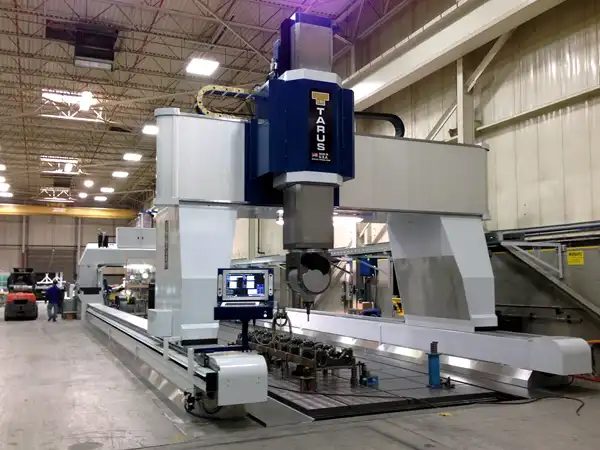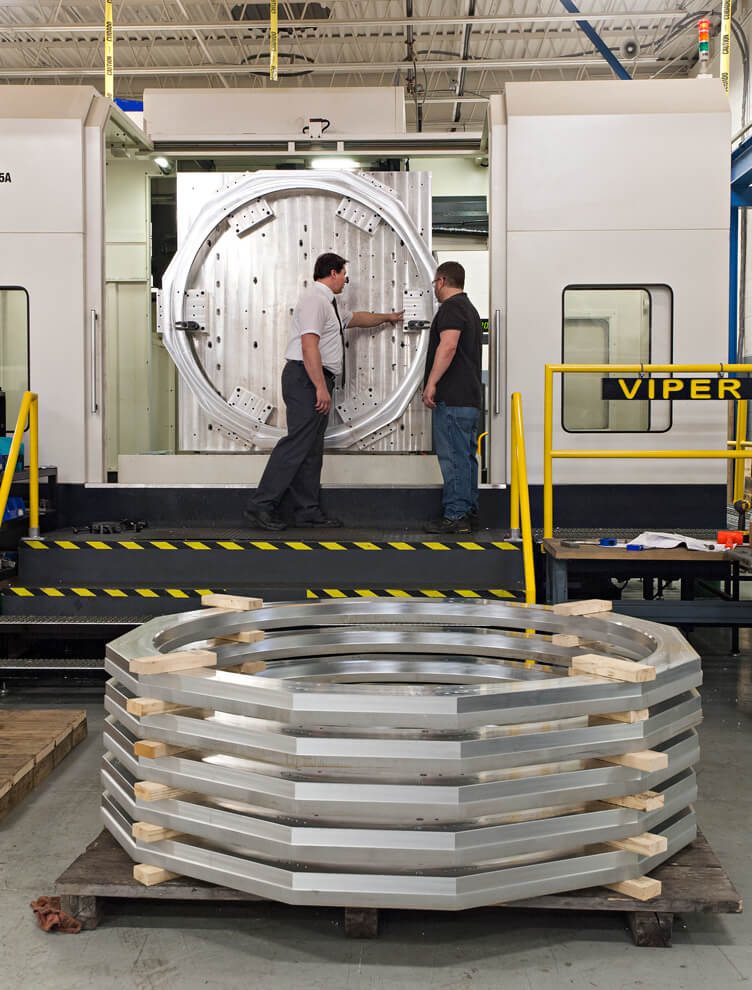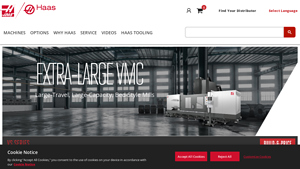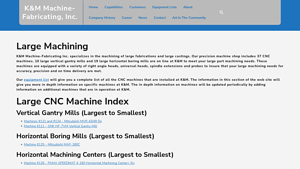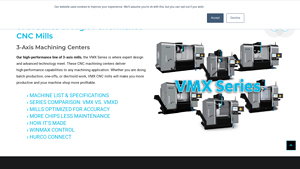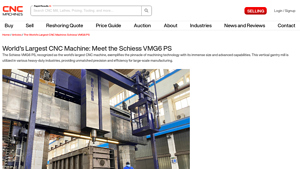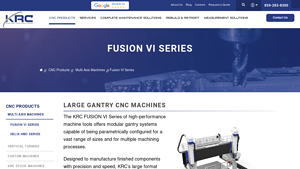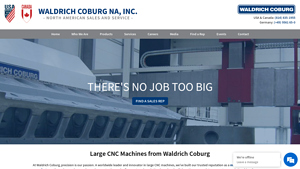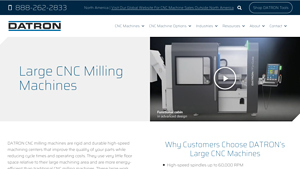Large Cnc Mill Guide: Type, Cost, Top List…
Introduction: Navigating the Global Market for large cnc mill
In today’s rapidly evolving manufacturing landscape, sourcing a large CNC mill presents a formidable challenge for international B2B buyers. With diverse applications ranging from aerospace to automotive and heavy machinery, the demand for precision engineering equipment has never been higher. Buyers must navigate a complex web of suppliers, varying costs, and technology specifications to make informed decisions that align with their operational needs and budget constraints.
This comprehensive guide aims to demystify the global market for large CNC mills by exploring various types of machines, their applications, and essential considerations for supplier vetting. From understanding the intricacies of different milling technologies to evaluating long-term operational costs, this resource provides actionable insights tailored for B2B buyers in regions such as Africa, South America, the Middle East, and Europe, including emerging markets like Saudi Arabia and Vietnam.
By equipping decision-makers with the knowledge to assess quality, reliability, and value, this guide empowers organizations to streamline their procurement processes and invest in machinery that drives productivity and competitiveness. Whether you’re a seasoned professional or new to the CNC landscape, our guide serves as a vital tool for navigating the complexities of sourcing large CNC mills in today’s global marketplace.
Understanding large cnc mill Types and Variations
| Type Name | Key Distinguishing Features | Primary B2B Applications | Brief Pros & Cons for Buyers |
|---|---|---|---|
| Vertical Machining Center (VMC) | High precision, vertical spindle orientation, often with automatic tool changers | Aerospace, automotive, and mold making | Pros: High accuracy and versatility. Cons: Limited to vertical operations. |
| Horizontal Machining Center (HMC) | Horizontal spindle, larger work envelope, and better chip management | Heavy-duty machining, large part manufacturing | Pros: Efficient for large parts, better cooling. Cons: Higher initial investment. |
| Gantry Mills | Large work area, dual-column design, suitable for heavy workpieces | Shipbuilding, aerospace components | Pros: Excellent for oversized parts. Cons: Requires significant floor space. |
| 5-Axis CNC Mills | Multi-axis machining capabilities, complex geometries | Complex components in aerospace and medical | Pros: Reduces setup time and increases precision. Cons: More complex programming needed. |
| Bridge Mills | Sturdy construction, large work envelope, ideal for heavy-duty applications | Heavy industrial applications, large molds | Pros: High rigidity and stability. Cons: Can be expensive and space-consuming. |
What Are the Characteristics of Vertical Machining Centers (VMC)?
Vertical Machining Centers (VMC) are distinguished by their vertical spindle orientation, which allows for precise vertical operations. They are equipped with automatic tool changers, making them ideal for high-volume production runs. VMCs are particularly suitable for industries like aerospace and automotive, where precision and repeatability are paramount. When considering a VMC, buyers should evaluate the machine’s spindle speed, tooling options, and software compatibility to ensure it meets their specific production needs.
How Do Horizontal Machining Centers (HMC) Differ from VMCs?
Horizontal Machining Centers (HMC) feature a horizontal spindle design, which provides a larger work envelope and more efficient chip removal compared to VMCs. This makes HMCs particularly effective for machining large parts and heavy-duty applications. Industries such as heavy machinery and automotive benefit from HMCs due to their ability to handle complex geometries and reduce cycle times. Buyers should assess the machine’s size, tooling capabilities, and coolant systems to maximize productivity.
Why Choose Gantry Mills for Large Workpieces?
Gantry Mills are characterized by their dual-column design, offering a large work area for handling oversized components. This makes them ideal for applications in shipbuilding and aerospace, where parts can be extremely large and heavy. Gantry Mills excel in stability and rigidity, which is essential for maintaining precision during machining. Potential buyers should consider floor space requirements and the machine’s load capacity when evaluating Gantry Mills for their operations.
What Are the Benefits of 5-Axis CNC Mills?
5-Axis CNC Mills provide the ability to machine complex geometries with high precision by allowing movement across five different axes simultaneously. This capability is particularly advantageous in industries such as aerospace and medical device manufacturing, where intricate designs are common. While they can significantly reduce setup times and improve accuracy, buyers should be aware of the increased complexity in programming and operation. It is crucial to ensure that the workforce is adequately trained to utilize these advanced machines effectively.
How Do Bridge Mills Provide Stability for Heavy-Duty Applications?
Bridge Mills are built with a robust structure, featuring a large work envelope that can accommodate heavy-duty machining tasks. They are particularly well-suited for industries requiring high rigidity and stability, such as mold making and large industrial applications. Buyers should consider the machine’s weight capacity, rigidity, and overall footprint to ensure it aligns with their production needs. While they can be a significant investment, their durability and performance often justify the cost in high-demand environments.
Key Industrial Applications of large cnc mill
| Industry/Sector | Specific Application of large cnc mill | Value/Benefit for the Business | Key Sourcing Considerations for this Application |
|---|---|---|---|
| Aerospace | Precision machining of aircraft components | Enhances safety and performance through accuracy | Certification compliance, material specifications, and lead times. |
| Automotive | Manufacturing engine blocks and transmission cases | Increases production efficiency and reduces waste | Tooling flexibility, capacity for large parts, and after-sales support. |
| Oil & Gas | Fabrication of drilling equipment | Reduces downtime and improves reliability | Material durability, ability to handle heavy-duty machining, and service options. |
| Heavy Machinery | Production of large structural components | Ensures structural integrity and longevity | Precision capabilities, custom tooling options, and maintenance services. |
| Shipbuilding | Machining of hull sections and engine mounts | Facilitates faster assembly and improved quality | Size constraints, environmental considerations, and integration with existing systems. |
How is a Large CNC Mill Used in the Aerospace Industry?
In the aerospace sector, large CNC mills are pivotal for precision machining of aircraft components such as wings, fuselages, and engine parts. These machines ensure that components meet stringent safety and performance standards. International buyers must consider certification compliance, as parts often require adherence to specific aviation regulations. Additionally, the choice of materials is critical, as they must withstand extreme conditions. Lead times are also essential to maintain production schedules.
What Role Does a Large CNC Mill Play in the Automotive Sector?
In automotive manufacturing, large CNC mills are employed to produce engine blocks, transmission cases, and other critical components. Their ability to perform high-volume production while maintaining tight tolerances significantly enhances efficiency and reduces material waste. Buyers should prioritize tooling flexibility to accommodate various designs and the capacity for large parts to meet diverse production needs. After-sales support is also crucial, as it ensures ongoing machine performance and reliability.
How are Large CNC Mills Utilized in the Oil & Gas Industry?
Large CNC mills serve a vital role in the oil and gas industry by fabricating drilling equipment, including drill bits and casing components. The precision and durability of these machines contribute to reducing downtime and enhancing equipment reliability in harsh environments. Buyers from this sector should focus on sourcing machines that can handle heavy-duty machining, as well as materials that offer durability against wear. Service options, including maintenance and support, are also important to ensure operational continuity.
In What Ways Do Large CNC Mills Benefit Heavy Machinery Manufacturing?
In heavy machinery manufacturing, large CNC mills are essential for producing large structural components such as frames and chassis. These machines ensure that the parts maintain structural integrity and longevity, which is critical in heavy-duty applications. Buyers should look for precision capabilities that can handle complex geometries and custom tooling options to meet specific project requirements. Additionally, access to maintenance services can help prolong the lifespan of the equipment.
How are Large CNC Mills Used in Shipbuilding?
In shipbuilding, large CNC mills are utilized for machining hull sections and engine mounts, which are crucial for the assembly of ships. The precision offered by these machines facilitates faster assembly processes and improves overall quality. Buyers should consider size constraints when sourcing equipment, as well as environmental regulations that may impact machining processes. Integration capabilities with existing systems are also vital to streamline operations and enhance productivity.
3 Common User Pain Points for ‘large cnc mill’ & Their Solutions
Scenario 1: Navigating High Initial Costs of Large CNC Mills
The Problem:
B2B buyers often face the daunting challenge of the high upfront costs associated with purchasing a large CNC mill. For companies in regions like Africa or South America, where capital budgets may be limited, the financial burden can be overwhelming. This scenario is exacerbated by the need to consider additional expenses such as tooling, maintenance, and training, which can further strain resources. Buyers may feel pressured to choose lower-cost alternatives, risking quality and long-term performance, leading to future operational inefficiencies.
The Solution:
To alleviate this pain point, buyers should conduct a comprehensive cost-benefit analysis before making a purchase. This includes evaluating not just the sticker price of the machine but also the total cost of ownership over its lifecycle. It is advisable to engage with manufacturers who offer financing options or leasing arrangements that can spread the financial burden. Additionally, seeking out suppliers that provide bundled packages—including tooling and maintenance—can reduce initial costs. Buyers should also consider the potential for increased productivity and efficiency, which can offset initial expenses through higher output and reduced operational costs over time.
Scenario 2: Addressing Technical Complexity and Skill Gaps
The Problem:
Many B2B buyers struggle with the technical complexity of operating large CNC mills, particularly if their workforce lacks the necessary skills. In industries where precision and efficiency are paramount, the inability to fully utilize machine capabilities can lead to production delays, increased waste, and subpar product quality. Companies in regions like the Middle East and Europe may find it challenging to source skilled technicians, resulting in a gap between the technology and the workforce’s capabilities.
The Solution:
To overcome this challenge, companies should invest in comprehensive training programs for their operators. Collaborating with machine manufacturers that offer robust training modules can ensure that staff are well-equipped to operate CNC mills effectively. Additionally, implementing mentorship programs where experienced operators guide newer staff can foster a culture of learning. Companies should also explore the possibility of remote assistance or online training resources that can help bridge knowledge gaps. By prioritizing workforce development, organizations can maximize their investment in large CNC mills, leading to improved operational efficiency.
Scenario 3: Managing Maintenance and Downtime
The Problem:
Unplanned downtime due to maintenance issues can severely disrupt production schedules and lead to significant financial losses. Buyers of large CNC mills often grapple with the unpredictability of maintenance needs, particularly in regions where spare parts may not be readily available. This uncertainty can result in extended periods of inactivity, affecting project timelines and customer satisfaction.
The Solution:
To mitigate maintenance-related issues, buyers should establish a proactive maintenance strategy. This involves scheduling regular maintenance checks and investing in predictive maintenance technologies that utilize data analytics to anticipate potential failures before they occur. Collaborating with suppliers who provide comprehensive after-sales support, including quick access to spare parts and expert service, is crucial. Additionally, maintaining a stock of critical spare parts on-site can help reduce downtime. By fostering a strong relationship with the equipment manufacturer or service provider, companies can ensure that they have the necessary support to keep their large CNC mills running smoothly and efficiently.
Strategic Material Selection Guide for large cnc mill
When selecting materials for large CNC mills, it’s essential to consider their properties, advantages, disadvantages, and how they align with the specific needs of international B2B buyers. Below is an analysis of four common materials used in the construction of large CNC mills: cast iron, aluminum, steel, and epoxy granite.
What Are the Key Properties of Cast Iron for Large CNC Mills?
Cast iron is renowned for its excellent damping properties, which reduce vibrations during machining. It typically has a high compressive strength and good wear resistance, making it suitable for heavy-duty applications. Cast iron can withstand high temperatures and pressures, which is crucial for maintaining precision in machining operations. However, it is relatively brittle, which can lead to cracking under extreme stress.
Pros & Cons: The durability of cast iron is a significant advantage; it can last for decades with proper maintenance. However, its weight can complicate transportation and installation, leading to higher initial costs. Additionally, the manufacturing complexity is moderate, as it requires specialized casting processes.
Impact on Application: Cast iron is compatible with various machining processes, making it ideal for industries requiring high precision, such as aerospace and automotive.
Considerations for International Buyers: Buyers should ensure compliance with international standards like ASTM A48 or DIN 1691. In regions like Africa and South America, local sourcing of cast iron may affect lead times and costs.
How Does Aluminum Compare as a Material for Large CNC Mills?
Aluminum is lightweight and offers excellent machinability, making it a popular choice for components where weight reduction is essential. It has good corrosion resistance, which is beneficial in humid environments. Aluminum can also be anodized for enhanced surface durability.
Pros & Cons: The primary advantage of aluminum is its low weight, which facilitates easier handling and installation. However, it is less rigid than steel or cast iron, which can lead to deformation under heavy loads. The manufacturing complexity is low, with many suppliers providing ready-to-use extrusions.
Impact on Application: Aluminum is suitable for applications that require high-speed machining and lower loads, such as in the electronics and consumer goods sectors.
Considerations for International Buyers: Compliance with standards like ASTM B221 is crucial. Buyers in the Middle East and Europe may prefer aluminum due to its lightweight properties, but they should be aware of the potential for higher costs compared to steel.
What Are the Advantages of Using Steel in Large CNC Mills?
Steel is a versatile material known for its strength and durability. It can withstand high temperatures and pressures, making it suitable for demanding machining environments. Steel also has excellent weldability, allowing for complex structures to be formed.
Pros & Cons: The key advantage of steel is its strength-to-weight ratio, which allows for robust construction without excessive weight. However, steel can be prone to corrosion if not properly treated, and its machining can be more complex compared to aluminum.
Impact on Application: Steel is often used in industries requiring high precision and durability, such as heavy machinery and construction.
Considerations for International Buyers: Buyers should verify compliance with standards like ASTM A36 or JIS G3101. In regions with high humidity, such as parts of Africa and South America, corrosion-resistant treatments may be necessary.
What Role Does Epoxy Granite Play in Large CNC Mills?
Epoxy granite is a composite material that combines epoxy resin with granite aggregates. It offers superior vibration damping and thermal stability, making it ideal for precision machining. Its non-metallic nature also eliminates issues related to rust and corrosion.
Pros & Cons: The primary advantage of epoxy granite is its ability to provide excellent surface finishes and extended tool life. However, it can be more expensive than traditional materials, and the manufacturing process is more complex.
Impact on Application: Epoxy granite is particularly suitable for high-precision applications in industries such as aerospace and medical devices.
Considerations for International Buyers: Compliance with specific standards may vary, and buyers should ensure that suppliers can meet their requirements. In Europe, for instance, there may be a preference for materials that meet stringent environmental regulations.
Summary Table of Material Selection for Large CNC Mills
| Material | Typical Use Case for large cnc mill | Key Advantage | Key Disadvantage/Limitation | Relative Cost (Low/Med/High) |
|---|---|---|---|---|
| Cast Iron | Heavy-duty machining applications | Excellent vibration damping | Brittle under extreme stress | Medium |
| Aluminum | High-speed machining | Lightweight and easy to handle | Less rigid than steel | Medium |
| Steel | Heavy machinery and construction | High strength and durability | Prone to corrosion | Medium |
| Epoxy Granite | Precision machining | Superior vibration damping and stability | Higher cost and complex manufacturing | High |
This analysis provides a comprehensive overview of material selection for large CNC mills, enabling international B2B buyers to make informed decisions based on their specific requirements and regional considerations.
In-depth Look: Manufacturing Processes and Quality Assurance for large cnc mill
What Are the Key Manufacturing Processes for Large CNC Mills?
The manufacturing process for large CNC mills involves several critical stages, each designed to ensure that the final product meets stringent quality standards. The main stages include material preparation, forming, assembly, and finishing. Understanding these stages is vital for B2B buyers seeking to ensure reliability and performance in their purchases.
How Is Material Prepared for Large CNC Mills?
Material preparation is the initial step in the manufacturing process. Typically, high-quality materials such as steel or aluminum alloys are selected based on the specific requirements of the CNC mill. This selection often involves evaluating mechanical properties, corrosion resistance, and machinability.
Once the materials are chosen, they undergo processes such as cutting and machining to achieve the necessary dimensions. Advanced techniques like waterjet cutting or laser cutting may be utilized to ensure precision. Additionally, thorough inspection of incoming materials is conducted, often referred to as Incoming Quality Control (IQC), to guarantee compliance with specified standards.
What Forming Techniques Are Commonly Used?
The forming stage involves transforming raw materials into the desired shapes through various machining processes. For large CNC mills, this typically includes processes like milling, turning, and grinding. CNC machining centers utilize computer numerical control (CNC) systems, enabling high precision and repeatability.
In this stage, the components are machined to exact specifications, with tolerances often within a few micrometers. The choice of tooling and cutting parameters, such as feed rate and spindle speed, is critical to achieving optimal results. Advanced techniques, such as 5-axis machining, can be employed to enhance flexibility and reduce setup times.
How Is Assembly Conducted for Large CNC Mills?
Once individual components are machined, they are assembled into the complete CNC mill. This stage requires skilled labor and specialized tools to ensure that all parts fit together accurately. Key components, such as the spindle, bed, and control system, are carefully aligned and secured.
Quality checks during assembly, known as In-Process Quality Control (IPQC), are essential. These checks include verifying the alignment of critical components and ensuring that all connections are secure. Assembly often involves the use of specialized jigs and fixtures to maintain precision throughout the process.
What Finishing Processes Are Important for Large CNC Mills?
The finishing stage enhances the aesthetic appeal and functional performance of the CNC mill. Common processes include surface treatment, painting, and coating. These processes not only improve the appearance but also provide protection against wear and corrosion.
Finishing techniques such as anodizing, powder coating, or applying a protective oil can significantly extend the lifespan of the machine. Additionally, final inspections, known as Final Quality Control (FQC), are performed to assess surface quality and overall appearance before the product is shipped.
What Quality Assurance Measures Are Essential for Large CNC Mills?
Quality assurance (QA) is a critical component of the manufacturing process for large CNC mills, ensuring that the machines meet international standards and customer expectations. Various international and industry-specific standards guide these practices, including ISO 9001, CE marking, and API certifications.
How Do International Standards Influence Quality Control?
ISO 9001 is a widely recognized quality management standard that outlines a framework for consistent quality in manufacturing processes. Compliance with ISO 9001 indicates that a manufacturer has established a robust quality management system (QMS) that includes documented processes, continual improvement, and customer satisfaction.
CE marking is essential for products sold in the European market, indicating compliance with safety and environmental requirements. For regions like Africa and South America, understanding local regulations and certification requirements is crucial, as they may differ significantly from European standards.
What Are the Key Quality Control Checkpoints?
Quality control checkpoints are integrated at various stages of the manufacturing process:
- Incoming Quality Control (IQC): Assessing materials upon arrival to ensure they meet specified standards.
- In-Process Quality Control (IPQC): Conducting checks during the manufacturing process to identify and rectify any issues early.
- Final Quality Control (FQC): Performing a comprehensive inspection of the finished product to ensure it meets all specifications.
These checkpoints help mitigate risks and enhance product reliability.
What Testing Methods Are Commonly Used?
Common testing methods for large CNC mills include:
- Functional Testing: Verifying that all machine functions operate correctly.
- Performance Testing: Assessing the machine’s ability to meet specified performance metrics, such as speed and accuracy.
- Stress Testing: Evaluating the machine’s durability under extreme conditions.
B2B buyers should inquire about the specific testing methods employed by manufacturers to ensure the machines’ reliability.
How Can B2B Buyers Verify Supplier Quality Control?
For international B2B buyers, verifying a supplier’s quality control processes is essential to mitigate risks associated with cross-border purchases. Here are several actionable steps:
What Steps Can Buyers Take to Audit Suppliers?
-
Request Documentation: Buyers should ask for certifications, quality management system documentation, and inspection reports to assess the manufacturer’s adherence to quality standards.
-
Conduct On-Site Audits: Visiting the manufacturing facility can provide valuable insights into the quality control processes in place. This allows buyers to evaluate the equipment, staff qualifications, and overall production environment.
-
Engage Third-Party Inspectors: Utilizing third-party inspection services can offer an unbiased assessment of the manufacturing processes and product quality. This is particularly important for buyers in regions with less stringent local regulations.
What Nuances Should Buyers Be Aware of in International Transactions?
International buyers should be aware of the nuances in quality control certifications and standards that may differ across regions. For instance, while ISO 9001 is globally recognized, local standards in Africa or South America might have unique requirements. Understanding these differences can aid buyers in making informed decisions and ensuring compliance with local regulations.
Additionally, buyers should consider the potential for variations in supply chain logistics, which can impact delivery times and product availability. Establishing clear communication channels with suppliers can help mitigate these risks and foster a collaborative relationship.
In summary, the manufacturing processes and quality assurance measures for large CNC mills are multifaceted and critical for ensuring product reliability. By understanding these processes, B2B buyers can make informed decisions that align with their operational needs and quality expectations.
Practical Sourcing Guide: A Step-by-Step Checklist for ‘large cnc mill’
To ensure a successful procurement process for a large CNC mill, it’s essential to follow a structured approach. This guide outlines key steps that international B2B buyers should take to secure the right machine for their operational needs.
Step 1: Define Your Technical Specifications
Start by clearly outlining the technical requirements of your CNC mill. Consider factors such as the size of the workpieces, the materials to be machined, and the complexity of the operations.
– Key Specifications: Look for features like spindle speed, axis travel, and tooling compatibility that match your production needs.
Step 2: Set a Realistic Budget
Establish a budget that encompasses not just the initial purchase price but also installation, training, maintenance, and potential operational costs.
– Cost Considerations: Ensure you include costs for optional features and accessories that may enhance the machine’s capabilities, such as automatic tool changers or advanced cooling systems.
Step 3: Research Potential Suppliers
Conduct thorough research to identify reputable suppliers that specialize in large CNC mills.
– Supplier Vetting: Review company profiles, customer testimonials, and case studies. It’s also beneficial to check for partnerships with well-known brands, as this can indicate reliability and quality.
Step 4: Verify Supplier Certifications
Before proceeding with any supplier, ensure they have the necessary certifications and adhere to international quality standards.
– Importance of Certifications: Certifications like ISO 9001 can provide assurance of the supplier’s commitment to quality management systems, which is crucial for high-value machinery.
Step 5: Request Demonstrations or Trials
Whenever possible, request a demonstration of the CNC mill in action or inquire about trial periods.
– Why This Matters: A hands-on experience allows you to assess the machine’s performance, ease of use, and suitability for your specific applications, helping you make a more informed decision.
Step 6: Evaluate After-Sales Support and Warranty
Look into the after-sales support offered by the supplier, including warranty details and maintenance services.
– Support Assessment: A strong support system can significantly reduce downtime and operational disruptions. Check for the availability of spare parts and response times for service requests.
Step 7: Compare Financing Options
Explore different financing options available for your purchase. Many suppliers offer flexible payment plans or leasing options that can ease the financial burden.
– Financing Benefits: Understanding your financing options can help you manage cash flow better and potentially invest in additional capabilities or upgrades down the line.
By following these steps, B2B buyers can effectively navigate the procurement process for large CNC mills, ensuring that they select the right equipment to meet their operational needs while maintaining budgetary constraints.
Comprehensive Cost and Pricing Analysis for large cnc mill Sourcing
What Are the Key Cost Components in Large CNC Mill Sourcing?
When sourcing large CNC mills, understanding the cost structure is essential for making informed purchasing decisions. The primary components influencing the overall cost include:
-
Materials: The choice of materials directly affects durability and performance. Common materials for CNC mills include cast iron, epoxy granite, and high-strength alloys. The sourcing of these materials can vary significantly in price based on market conditions and geographic location.
-
Labor: Labor costs encompass both direct manufacturing labor and skilled technicians required for assembly and quality assurance. In regions with higher labor rates, such as Western Europe, this can significantly increase the cost of a CNC mill.
-
Manufacturing Overhead: This includes costs related to factory maintenance, utilities, and administrative expenses. These overhead costs can vary widely depending on the manufacturer’s location and operational efficiency.
-
Tooling: Tooling costs involve the purchase of specific tools and fixtures required for the machining process. Advanced mills may require more specialized tooling, which can add to the upfront investment.
-
Quality Control (QC): Robust QC processes ensure that each machine meets stringent performance standards. The costs associated with QC can vary depending on the complexity and precision required.
-
Logistics: The transportation of large CNC mills can be a significant cost factor, especially for international buyers. Factors such as shipping methods, insurance, and customs duties can add considerable expense.
-
Margin: Suppliers typically add a profit margin to the base cost of the machine. Understanding standard margins in the industry can help buyers negotiate better deals.
How Do Price Influencers Impact Large CNC Mill Costs?
Several factors can influence the pricing of large CNC mills, including:
-
Volume/MOQ: Larger orders can lead to volume discounts. Manufacturers often provide better pricing for bulk purchases, so negotiating minimum order quantities (MOQ) can yield cost savings.
-
Specifications and Customization: Custom features and specifications can significantly increase costs. Buyers should clearly define their needs to avoid unnecessary expenses.
-
Materials: The choice of materials not only affects the initial cost but also influences longevity and maintenance. High-quality materials may have a higher upfront cost but could lead to lower Total Cost of Ownership (TCO) over time.
-
Quality and Certifications: Compliance with international quality standards can add to the cost. Buyers should consider whether certifications such as ISO 9001 are necessary for their operations.
-
Supplier Factors: The reputation and experience of the supplier can influence pricing. Established suppliers may charge more due to their proven reliability and support services.
-
Incoterms: Understanding Incoterms is crucial for international transactions. Different shipping terms can affect the final cost, including who bears the responsibility for shipping, insurance, and tariffs.
What Are Effective Buyer Tips for Sourcing Large CNC Mills?
To navigate the complexities of sourcing large CNC mills, international buyers can employ several strategies:
-
Negotiation: Always engage in negotiations. Understanding the cost components can empower buyers to negotiate better terms and pricing. Leverage multiple quotes to establish a competitive environment.
-
Cost-Efficiency: Focus on the Total Cost of Ownership rather than just the initial purchase price. This includes maintenance, operational costs, and potential downtime, which can significantly impact overall expenses.
-
Pricing Nuances for International Buyers: Recognize that pricing can vary by region due to labor costs, tariffs, and logistics. Buyers from Africa, South America, the Middle East, and Europe should consider these factors when making purchasing decisions.
-
Research and Due Diligence: Thoroughly research potential suppliers, including their history, customer reviews, and after-sales support. This can prevent costly mistakes and ensure a reliable partnership.
Disclaimer on Pricing Information
Prices for large CNC mills can fluctuate based on market conditions and specific requirements. This analysis provides indicative costs and factors influencing pricing but should not be considered definitive. Always consult with suppliers for the most accurate and up-to-date pricing information tailored to your specific needs.
Alternatives Analysis: Comparing large cnc mill With Other Solutions
Understanding Alternatives to Large CNC Mills
In the realm of precision machining, large CNC mills are often the go-to solution for high-volume production and complex parts fabrication. However, various alternative solutions can achieve similar objectives, each with its unique advantages and disadvantages. This section will compare large CNC mills with two viable alternatives: the Tormach 1500MX CNC Mill and traditional manual machining.
Comparison Table
| Comparison Aspect | Large CNC Mill | Tormach 1500MX CNC Mill | Manual Machining |
|---|---|---|---|
| Performance | High precision, robust speed | Moderate precision, good speed | Variable precision, slower speed |
| Cost | High initial investment | Moderate cost (starting at $32,995) | Low initial cost, but labor-intensive |
| Ease of Implementation | Requires skilled operators | User-friendly interface | Requires skilled machinists |
| Maintenance | High maintenance costs | Moderate maintenance | High labor and skill requirement |
| Best Use Case | Large-scale production runs | Small to medium production | Prototyping and one-off projects |
In-Depth Analysis of Alternatives
What Are the Advantages and Disadvantages of the Tormach 1500MX CNC Mill?
The Tormach 1500MX CNC Mill offers a cost-effective solution for businesses looking to enter CNC machining without the hefty price tag associated with large CNC mills. Its epoxy granite frame enhances vibration dampening, leading to improved surface finishes and tool longevity. With features like through-spindle coolant and a user-friendly PathPilot interface, it is accessible for operators with varying skill levels. However, while it provides decent performance for small to medium production runs, it may not match the speed and precision of larger CNC machines when tackling high-volume projects.
How Does Manual Machining Compare to Large CNC Mills?
Manual machining remains a viable alternative, particularly for prototyping or low-volume projects where flexibility is essential. The initial costs are significantly lower, and it allows for a hands-on approach, giving machinists the ability to make real-time adjustments. However, the precision and consistency are often less reliable than automated CNC processes. Manual machining also demands highly skilled labor, which can be a limiting factor for businesses in regions where skilled machinists are scarce.
Conclusion: How Should B2B Buyers Choose the Right Machining Solution?
When selecting the right machining solution, B2B buyers should assess their specific needs, including production volume, budget constraints, and the skill level of their workforce. Large CNC mills are ideal for high-volume production with demanding precision requirements, while the Tormach 1500MX offers a balanced approach for smaller operations looking to leverage CNC capabilities without excessive investment. Meanwhile, manual machining can be suitable for bespoke projects that require flexibility but comes with its own set of challenges in terms of labor and precision. Ultimately, understanding the unique attributes of each solution will empower buyers to make informed decisions that align with their operational objectives and market demands.
Essential Technical Properties and Trade Terminology for large cnc mill
What Are the Essential Technical Properties of a Large CNC Mill?
When considering a large CNC mill for industrial applications, several technical properties are crucial for ensuring optimal performance and productivity. Understanding these specifications can help B2B buyers make informed purchasing decisions.
1. Material Grade
The material grade of a CNC mill’s construction significantly affects its durability and precision. Common materials include cast iron, steel, and epoxy granite. Epoxy granite, for instance, offers superior vibration dampening, which enhances machining accuracy and extends tool life. B2B buyers should prioritize mills made from materials that meet their operational demands to minimize maintenance costs and downtime.
2. Tolerance Levels
Tolerance levels indicate the permissible limits of variation in dimensions and are critical for precision machining. A CNC mill with tight tolerance levels (e.g., ±0.0001 inches) ensures that components meet stringent quality standards, which is vital in industries like aerospace and automotive. Understanding tolerance requirements helps buyers select machines that align with their manufacturing standards, reducing the risk of defects and rework.
3. Spindle Speed and Power
The spindle speed (measured in RPM) and power (in horsepower or kW) are essential for determining a CNC mill’s cutting capabilities. High spindle speeds (e.g., 10,000 RPM or more) allow for faster machining of materials, while adequate power ensures efficient material removal. Buyers should assess their specific applications to ensure the mill’s spindle specifications align with their production needs, maximizing efficiency and output.
4. Axis Travels
Axis travels refer to the maximum distances the machine can move in the X, Y, and Z directions. Larger travel distances enable the machining of bigger workpieces without the need for repositioning. For buyers in sectors that handle large components, such as heavy machinery or mold-making, understanding these specifications is critical for optimizing workspace and workflow.
5. Feed Rate
The feed rate, typically measured in inches per minute (IPM), indicates how quickly the CNC mill can move the cutting tool across the workpiece. Higher feed rates can significantly reduce machining time, enhancing overall productivity. Buyers should evaluate the feed rates of various models to determine which machines can best accommodate their production schedules.
What Are Common Trade Terms Used in the CNC Milling Industry?
Familiarizing oneself with industry terminology can streamline the purchasing process and facilitate communication with suppliers. Here are several key terms often encountered in the CNC milling sector:
1. OEM (Original Equipment Manufacturer)
An OEM refers to a company that produces parts or equipment that may be marketed by another manufacturer. In the CNC milling context, buyers often source machines from OEMs that provide reliable warranties and support. Understanding OEM relationships can help buyers ensure they are purchasing high-quality equipment.
2. MOQ (Minimum Order Quantity)
MOQ denotes the smallest quantity of a product that a supplier is willing to sell. This term is crucial for B2B buyers who need to plan their inventory and budget. Knowing the MOQ can help in negotiating bulk purchases and securing better pricing.
3. RFQ (Request for Quotation)
An RFQ is a standard business process wherein buyers request price quotes from suppliers for specific products or services. In the CNC milling industry, submitting an RFQ allows buyers to gather competitive pricing and terms from multiple vendors, facilitating informed decision-making.
4. Incoterms (International Commercial Terms)
Incoterms are standardized trade terms used in international contracts to define the responsibilities of buyers and sellers regarding shipping, insurance, and tariffs. Familiarity with Incoterms is essential for B2B buyers involved in cross-border transactions, as it clarifies who bears the risk and costs at various stages of the shipping process.
5. CAD (Computer-Aided Design)
CAD refers to software used for creating precision drawings or technical illustrations. In CNC milling, CAD files are often required to program the machine. Understanding CAD is beneficial for buyers as it ensures compatibility with their design processes and enhances workflow efficiency.
By grasping these technical properties and industry terms, B2B buyers can make better-informed decisions when investing in large CNC mills, ultimately contributing to more efficient and productive manufacturing operations.
Navigating Market Dynamics and Sourcing Trends in the large cnc mill Sector
What Are the Key Trends Shaping the Large CNC Mill Market?
The global market for large CNC mills is being significantly influenced by several key drivers. The increasing demand for precision machining across various industries, including aerospace, automotive, and manufacturing, is propelling growth. Additionally, the rise of Industry 4.0 technologies, such as IoT integration and data analytics, is transforming traditional manufacturing processes into smart factories, allowing for enhanced efficiency and reduced downtime.
International B2B buyers, particularly from Africa, South America, the Middle East, and Europe, should also be aware of the growing trend towards customization and flexibility in CNC machining solutions. Manufacturers are increasingly offering modular systems that can be tailored to specific production needs, which is vital for companies looking to maintain competitive advantages in rapidly changing markets. Furthermore, the shift towards automation and robotics in machining processes is allowing for higher productivity and lower labor costs, making it an attractive investment for businesses seeking to scale operations.
Emerging sourcing trends indicate a growing preference for local suppliers to mitigate supply chain risks and enhance responsiveness. This shift is particularly relevant for regions like Africa and South America, where establishing robust local supply chains can lead to significant cost savings and improved delivery times. Additionally, sustainability is becoming a crucial factor in sourcing decisions, with buyers increasingly favoring suppliers that demonstrate environmental responsibility and ethical practices.
How Important Is Sustainability and Ethical Sourcing in the Large CNC Mill Sector?
Sustainability is rapidly becoming a top priority for B2B buyers in the large CNC mill sector. The environmental impact of manufacturing processes, including energy consumption and waste production, is under scrutiny. Companies are now expected to adopt practices that minimize their ecological footprint, leading to a demand for CNC mills that utilize energy-efficient technologies and materials.
Ethical sourcing is equally critical, as buyers increasingly look for suppliers committed to responsible labor practices and transparent supply chains. Certifications such as ISO 14001 (Environmental Management) and ISO 45001 (Occupational Health and Safety) are becoming essential in supplier evaluations. Moreover, the use of sustainable materials, such as recycled steel and eco-friendly lubricants, is gaining traction. Buyers who prioritize these factors not only contribute to global sustainability efforts but also enhance their brand reputation and customer loyalty.
Incorporating green certifications and materials into procurement strategies is not just an ethical choice; it can also lead to cost savings through increased efficiency and reduced waste. As the market evolves, suppliers who align with these values will likely gain a competitive edge, making it imperative for buyers to stay informed about their sourcing options.
What Is the Evolution of Large CNC Mills in the B2B Landscape?
The evolution of large CNC mills has been marked by significant technological advancements since their inception. Initially, CNC mills were primarily mechanical machines that relied on manual programming, limiting their flexibility and efficiency. However, the introduction of computer numerical control in the late 20th century revolutionized the sector, enabling precise automated operations that significantly improved production capabilities.
As technology progressed, the focus shifted towards enhancing machine capabilities through innovations such as high-speed machining, multi-axis configurations, and advanced tooling systems. This evolution has been driven by the need for greater precision and efficiency in manufacturing processes. The recent integration of IoT and AI technologies into CNC machining has further transformed the landscape, allowing for real-time monitoring, predictive maintenance, and increased automation.
Today, large CNC mills are not only essential tools for manufacturing but also integral components of smart factories, reflecting the ongoing trend towards digitization and automation in the industry. For international B2B buyers, understanding this evolution is vital for making informed purchasing decisions that align with current technological capabilities and market demands.
Frequently Asked Questions (FAQs) for B2B Buyers of large cnc mill
-
How do I determine the right large CNC mill for my business needs?
To select the right large CNC mill, start by assessing your specific manufacturing requirements, including the types of materials you will be machining, the precision needed, and the complexity of your designs. Consider the machine’s travel dimensions, spindle speed, power, and the capabilities it offers, such as 5-axis machining or through-spindle coolant options. Additionally, evaluate the machine’s compatibility with your existing workflow and production capacity. Consulting with suppliers and industry experts can also provide insights tailored to your operational goals. -
What are the key specifications to look for in a large CNC mill?
When evaluating large CNC mills, focus on several key specifications: travel distance (X, Y, Z axes), spindle speed (RPM), power rating (continuous and peak), and the machine’s rigidity and stability, often determined by its frame material. Check for features such as tool changers, coolant systems, and software compatibility. Additionally, consider the machine’s maximum payload capacity and the type of tooling it supports, which can significantly impact your machining capabilities and production efficiency. -
What is the typical lead time for ordering a large CNC mill?
Lead times for large CNC mills can vary significantly based on factors such as the manufacturer, customization options, and global supply chain conditions. Generally, standard models may take anywhere from 8 to 12 weeks for delivery, while custom-built machines could require 12 to 24 weeks or more. It’s essential to discuss lead times with potential suppliers upfront to align your production schedules and avoid unexpected delays. -
How can I vet suppliers when sourcing a large CNC mill internationally?
Vetting suppliers involves thorough research and due diligence. Start by checking their industry reputation through reviews, testimonials, and case studies. Request references from past clients, especially those in your region or industry. Verify certifications and compliance with international quality standards such as ISO 9001. Additionally, consider visiting the supplier’s facility if possible or engaging a third-party inspection service to assess their manufacturing capabilities and quality assurance processes. -
What customization options are typically available for large CNC mills?
Most manufacturers offer a range of customization options for large CNC mills to meet specific operational needs. Customizations may include modifications to travel distances, spindle configurations, and additional features like automatic tool changers or advanced cooling systems. Buyers can also request software adaptations for specific machining processes. Discussing your requirements early in the buying process can help ensure that the final machine aligns with your production goals and enhances efficiency. -
What are the minimum order quantities (MOQ) for large CNC mills?
Minimum order quantities for large CNC mills can vary by manufacturer and the specific model requested. Many suppliers do not have a strict MOQ for single machine purchases, especially for standard models. However, for custom machines or bulk orders, you may encounter MOQs that range from 1 to several units. It’s advisable to clarify MOQs during your initial discussions with suppliers to understand any potential volume discounts or pricing structures. -
What payment terms should I expect when purchasing a large CNC mill?
Payment terms for large CNC mill purchases can differ widely based on the supplier and your negotiation. Common arrangements include a deposit (typically 20-50%) upon order confirmation, with the balance due prior to shipping. Some suppliers may offer financing options or extended payment plans. Always ensure that payment terms are clearly outlined in the purchase agreement and consider escrow services for high-value transactions to mitigate risks. -
How do logistics and shipping work for large CNC mills?
Logistics for shipping large CNC mills involve several critical steps. After manufacturing, the mill is usually packaged in a crate for protection during transit. Considerations include the shipping method (air, sea, or land), which can affect costs and delivery times. It’s essential to work with your supplier and logistics provider to arrange transport that complies with international regulations and customs procedures. Additionally, ensure that installation and setup services are included or available upon delivery to facilitate a smooth transition into your operations.
Important Disclaimer & Terms of Use
⚠️ Important Disclaimer
The information provided in this guide, including content regarding manufacturers, technical specifications, and market analysis, is for informational and educational purposes only. It does not constitute professional procurement advice, financial advice, or legal advice.
While we have made every effort to ensure the accuracy and timeliness of the information, we are not responsible for any errors, omissions, or outdated information. Market conditions, company details, and technical standards are subject to change.
B2B buyers must conduct their own independent and thorough due diligence before making any purchasing decisions. This includes contacting suppliers directly, verifying certifications, requesting samples, and seeking professional consultation. The risk of relying on any information in this guide is borne solely by the reader.
Top 7 Large Cnc Mill Manufacturers & Suppliers List
1. Haas – VS Series VMCs
Domain: haascnc.com
Registered: 1996 (29 years)
Introduction: This company, Haas – VS Series VMCs, is a notable entity in the market. For specific product details, it is recommended to visit their website directly.
2. K&M Machine-Fabricating – Large CNC Machining Solutions
Domain: k-mm.com
Registered: 2000 (25 years)
Introduction: K&M Machine-Fabricating, Inc. specializes in large CNC machining with 37 CNC machines, including 10 large vertical gantry mills and 19 large horizontal boring mills. Key machines include:
1. **Mitsubishi MVR 43/49 Dx Vertical Gantry Mills (Machines #121 and #124)**
– **Pallet Size:** 3,500 MM x 8,000 MM
– **X Axis Travel:** 9,000 MM
– **Y Axis Travel:** 4,900 MM
– **Z Axis Column…
3. Hurco – VMX Series CNC Mills
Domain: hurco.com
Registered: 1994 (31 years)
Introduction: VMX Series of High-Performance CNC Mills
– Type: 3-Axis Machining Centers
– Travel Range: 24 x 20 to 84 x 34
– Spindle Options: 12K Big Plus® 40-taper spindles, Big Plus® CAT 50 spindle options for X-axis travel of 50 and larger
– VMXD Models: VMX24Di (24 x 20), VMX30Di (30 x 20), VMX42Di (42 x 24)
– Direct-Drive Spindle: 15,000 RPMs for VMXD models
– Key Benefits: Faster chip-to-chip time, less h…
4. Schiess – VMG6 PS CNC Machine
Domain: cncmachines.com
Registered: 1997 (28 years)
Introduction: {“Product Name”: “Schiess VMG6 PS”, “Type”: “CNC Machine”, “Specifications”: {“Turning Table Diameter”: “236.22 inches (6,000 mm)”, “Distance Between Columns”: “314.96 inches (8,000 mm)”, “Working Length”: “826.77 inches (21,000 mm)”, “Working Height”: “185.04 inches (4,700 mm)”, “Maximum Load Capacity”: “550,000 lbs (250 metric tons)”}, “Features”: [“Advanced Control Systems”, “Robust Constructio…
5. KRC – FUSION VI Gantry System
Domain: krcmachinetoolsolutions.com
Registered: 2009 (16 years)
Introduction: Large Format CNC Machining – Gantry Machine
– Product Series: KRC FUSION VI
– Type: Modular gantry system
– Capabilities: Trimming, drilling, routing, surface milling, marking, inspection
– Designed for: Large format parts in various materials
– Industries: Aerospace, transportation, energy
– Stroke:
– Base Axis (X, U): 9 to 36 m (354 to 1417 in.)
– Bridge Axis (Y1, Y2): 3 to 6.5 m (118 to 256…
6. Waldrich Coburg – CNC Machines
Domain: waldrich-coburg.com
Registered: 2005 (20 years)
Introduction: Large CNC Machines from Waldrich Coburg include: 1. Vertical Milling Machines – Known as portal mills, bridge mills, or gantry mills, these machines use spinning tools attached to a spindle axis to remove material from a stationary workpiece. 2. Vertical Turning Lathes (VTL or VBM) – These machines utilize gravity to steady the spinning workpiece against various cutting tools. 3. Precision Grindin…
7. DATRON – Large CNC Milling Machines
Domain: datron.com
Registered: 1995 (30 years)
Introduction: DATRON offers a range of large CNC milling machines including the M8Cube, MLCube, MXCube, and M10 Pro. Key specifications include:
– **M8Cube**:
– Travel (XYZ): 1,020 x 830 x 245 mm (40″ x 33″ x 10″)
– Spindle Speed: Up to 60,000 RPM
– Weight: approx. 1,300 kg (2,866 lbs.)
– Working Area: 1,000 x 700 x 200 mm (39″ x 27.5″ x 7.5″)
– Tool Changer: Up to 143 stations
– **MLCube**: …
Strategic Sourcing Conclusion and Outlook for large cnc mill
In today’s competitive manufacturing landscape, strategic sourcing of large CNC mills is crucial for optimizing production capabilities and maximizing ROI. B2B buyers must prioritize factors such as machine reliability, technological advancements, and supplier support. Selecting a partner that offers comprehensive solutions, including automation options and robust after-sales service, can significantly enhance operational efficiency.
Investing in large CNC mills equipped with modern features—such as high-speed machining, advanced cooling systems, and user-friendly controls—ensures better performance and longer tool life. Buyers should also consider geographic advantages, ensuring their sourcing strategy aligns with local market conditions and logistical considerations.
As we look to the future, the demand for precision manufacturing will only increase. International buyers from Africa, South America, the Middle East, and Europe should seize opportunities to engage with innovative suppliers that can cater to their specific needs. By embracing strategic sourcing now, you position your business to thrive in an evolving industry. Explore your options today to ensure your manufacturing operations are equipped for tomorrow’s challenges.
